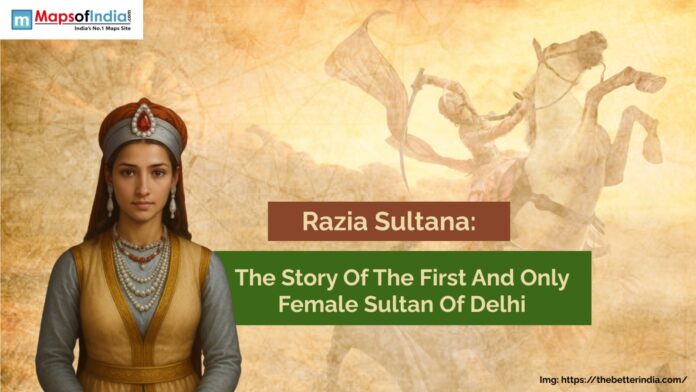The tales and legends of valorous kings, great and visionary leaders, and enthralling marriages of intrigue of their times abound in Indian history. But among the many kings who were on the throne of Delhi at some time, one figure stands out: Razia Sultana-she is unique and bold. Razia’s rule in the 13th century as the first and only woman Sultan of Delhi was a bold experiment with power, gender, and government. Particularly in a time when women’s rights and gender equality are increasingly important, her story, which is marked by extraordinary success and a sad ending, continues to inspire and challenge discussion.
Early Years and Upbringing
Born about 1205 CE, Razia Sultana was the daughter of Shams-ud-din Iltutmish, the third Mamluk (Slave) dynasty ruler who had come to dominate northern India following the fall of the Ghurid Empire. Razia received an education commensurate with her brothers, unlike most royal daughters. From an early age, Iltutmish, who had risen from slavery to the throne, saw Razia’s intelligence, administrative sense, and leadership capacity. Often accompanying her father in courtly and administrative tasks, she was taught statecraft, military tactics, and the subtleties of government.
In a deeply patriarchal society where women were mainly confined to domestic roles and hardly engaged in public life, this progressive approach was unique. Not only for Razia’s fate but also for the path of Indian history, Iltutmish’s choice to equip her for leadership would prove later to be crucial.
The Road of Authority
Rivalry and mystery abound in the Delhi throne succession. Razia was not immediately crowned upon Iltutmish’s death in 1236, despite her father’s unambiguous choice for her as his heir. Rather, the nobles placed her brother, Ruknuddin Firuz, whose rule rapidly descended into anarchy due to his incompetence and his mother, Shah Turkan’s manipulation. The government alienated the common people and the nobility by becoming well-known for its corruption and brutality.
Razia was sidelined and in danger of her life at the same time. During Friday prayers at the Jama Masjid, she directly addressed the people of Delhi in a dramatic episode criticising the excesses of Ruknuddin and Shah Turkan. Her fervent appeal set off public indignation, which resulted in a rebellion that brought Shah Turkan to be arrested and Ruknuddin to be sacked. Razia’s declaration of Sultan of Delhi in November 1236 rocked the conservative establishment.
Rules and Management
From 1236 to 1240, Razia Sultana’s rule was marked by audacious reforms, administrative excellence, and a dedication to justice. She started organising her power immediately and assigning capable officials from all backgrounds. Her most divisive appointment was that of Abyssinian (Ethiopian) slave Jamal-ud-Din Yaqut, chief of the royal stables, a post usually reserved for Turkish nobility. Although meant to challenge the monopoly of the Turkish elite, this action planted seeds of discontent among the strong nobility.
Notably, Razia’s administration was termed a hall-mark of inclusiveness and meritocracy. She battled against corruption, reinstated law and order, and promoted economic growth. Roads and wells were constructed, trade was promoted, and welfare measures were taken. She established libraries and schools with works in Persian, Arabic, and Sanskrit, supporting the arts and education. Her policies showed a secular perspective since she aimed to defend Islamic values while safeguarding the rights and culture of the Hindu majority.
Overcoming Gender Risks
The most remarkable aspect of Razia’s ascendance was her defiance of gender expectations. She removed the traditional veil or purdah and appeared in public wearing men’s clothes while conducting official business and personally leading her troops. This was not merely symbolic; it was the assertion of her authority, pragmatic in a context wherein power was inextricably linked with masculinity.
Razia’s court was a cosmopolitan venue that attracted academics, poets, and bureaucrats from all over the Islamic world. She promoted intellectual interaction and debate, creating a setting of cultural synthesis. However, her progressive policies and obvious assertion of female authority made her a target for conservative elements in the court and larger society.
Military Attacks and Internal Conflict
Razia actively engaged in military operations to defend and enlarge her territory but was not happy to be a token head of state. The Chahamana (Chauhan) king of Ranthambore presented her first significant obstacle since he had declared his independence following the death of Iltutmish. Razia personally commanded her army, effectively quelling the uprising and restoring the Sultanate’s power.
Razia’s posture remained unstable even with such achievements. Respecting her gender and depending on non-Turkish officials like Yaqut, the Turkish nobility started plotting against her. Using these rumours to support their opposition, court historians and chroniclers—many of whom were products of the same patriarchal milieu—often embellished or invented tales about Razia’s relationship with Yaqut.
The revolt and the fall from grace
By 1240, simmering resentment among the nobles burst into open revolt. Former friend Malik Ikhtiyar-ud-din Altunia, governor of Bhatinda, organised a rebellion against Razia. Yaqut was dead, and Altunia took Razia prisoner during the ensuing strife. In a stunning turn of events, Razia and Altunia reconciled and wed to create an alliance to recover the throne.
Their attempt to take Delhi back off, though, failed. Razia’s brother, Muizuddin Bahram, had taken over while she was away, and the Altunia and Razia’s combined army was routed. Razia and Altunia were killed on October 15, 1240, after their surviving supporters deserted them and local Jats captured them. Fleeing towards Kaithal, Razia buried herself in Delhi; her tomb silently bears evidence of her remarkable life.
Legacy and Historical Value
Though brief, Razia Sultana’s rule has left an ongoing legacy. She is regarded as a fair and competent king who aims to go beyond the constraints of her gender and the prejudices of her day. Her initiatives to advance cultural synthesis, education, and justice distinguishes her from many of her contemporaries.
Her narrative is of systematic challenge as much as of personal ambition. Razia’s father’s acceptance of her talents and the people’s support rather than the nobility made her climb to the throne possible. Her later battle against ingrained interests and final collapse drew attention to the opportunities and dangers women in positions of power in mediaeval India must negotiate.
Modern historians like Raziuddin Aquil and Rana Safvi have examined Razia’s life, separating fact from myth and stressing her significance as a trailblazer of women’s leadership in South Asia. The venerable Hindi film Razia Sultan (1983) introduced her story to a new generation, and her life has inspired innumerable works of literature, drama, and popular culture.
Razia Sultana’s life is a mosaic of valour, foresight, and endurance. As the first and only woman Sultan of Delhi, she smashed the social norms of her times, remodelled her land and left behind a legacy that is felt even today.




